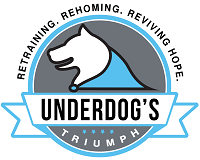In the past I have written about how to find a good dog trainer (see my past post here). First off, I LOVE it when my prospective clients ask me questions about my methods and techniques BEFORE agreeing to see me in person. I also truth be told, I do the same thing to them. At Underdog’s Triumph we start off all new clients with a consultation visit. This 1 to 1.5 hour visit includes a pre-questionnaire detailing what the client and their furry friend are experiencing and goes briefly into what they want to get from the training. Then that first session is almost entirely a question/answer and discussion session.
So many people want to just jump right in. Start training on day one. But I firmly believe that every dog, must like every client, is different. It’s important to hear them out and make sure they are comfortable with the decisions you are making together for their family. While I have a boatload of questions I like to ask my prospective clients to learn all about their situation, experiences with dogs and training, there are also some great questions to ask me as your prospective trainer! You can read more about these questions and other questions from Victoria Stilwell’s article about “How to find a Good Dog Trainer” I picked out my top four favorites from the article to share my opinion on what would be a good response!
Questions to Ask Your Prospective Trainer:
Note: ALWAYS be prepared to walk away from training if the trainer EVER suggests something you are uncomfortable with doing. Just because they are an “expert” doesn’t make them 100% right all the time. Suggesting things that hurt the dog or cause you to feel uncomfortable doing is a perfectly acceptable reason to stop immediately. Remember YOU are your dogs voice so use it for the both of you!
“How do you correct behavior?”
Ideal Response:
- Avoids the use of any aversive techniques or tools – prong collar, shock collars, e-collars, choke chains, pops/jerks on leash, tapping or hitting the dog with a foot or hand, etc
- Manages unwanted behavior to prevent it from continuing to happen.
- Selects a new alternative (desired) behavior which will replace the unwanted one
- Designs a training plan using reinforcement to increase the likelihood that the alternative behavior will be performed (and eventually replace the unwanted behavior).
More Info: Oddly enough a lot of people who are against using only force free or positive training methods seem to think that these types of trainers (of which I am one) are pushovers when trying to stop unwanted behavior. Since we can’t “correct” the dog with a harsh jerk or some other additive of pain, the dog jumps/walks all over us right? What they don’t understand is the dog doesn’t mean to do the wrong thing. To the dog, jumping all over guests isn’t wrong. It’s fun! They are excited to see a new person and jumping expresses this excitement and gets them closer to the visiting guests hands and face for pets/licks.
“Do you have liability insurance?”
Ideal Response: ABSOLUTELY! Ideally providing you proof this liability in the form of a card or written document.
More Info: A lot of trainers do not carry any kind of insurance and I don’t think that’s being responsible. For all the training and education we have, we’re still dealing with another living creature. We can do our best to predict what might happen in a training session, but we can’t predict everything and accidents can happen. Make sure your trainer has you both covered by having additional liability insurance to protect you both.
“Do you use rewards in training, and if so, what kind?”
Ideal Response: Yes! Absolutely!
More Info: A fantastic response should go on to talk about using different motivators inorder to find out what works for each dog. While almost all dogs are motivated by food (we all have to eat right?!) some also get a lot of enjoyment from toys or other creative things. My own dog, Luna for instance, LOVES blankets. Trainers should use these high value motivators and help you incorporate them into training. Life rewards are also great motivators – these are everyday things that dog enjoys. An example of a life reward might be having the dog sit by the door and after that sit, opening the door to let the dog out into the yard (aka granting access to a desired area). These types of rewards work great to incorporate into daily routines for daily activities.
“Can I speak to your past and current clients?”
Ideal Response: Of course! And provide a list of potential options.
More Info: I typically have ask past clients if they would be able to chat with new clients when requested. I like to pair past clients with potential clients based on the issue both dealt with. For example I did some new puppy socialization classes a while back, pairing up this client to a client with a fear aggressive dog would just be silly. The situations aren’t the same and the training for sure won’t be either. Apples to Apples works much better.
I strongly encourage you all to check out the article above (“How to find a Good Dog Trainer”) it has loads of great advice about finding the perfect fit trainer for you situation. And as always if you have questions, we’d love to hear from you 🙂
